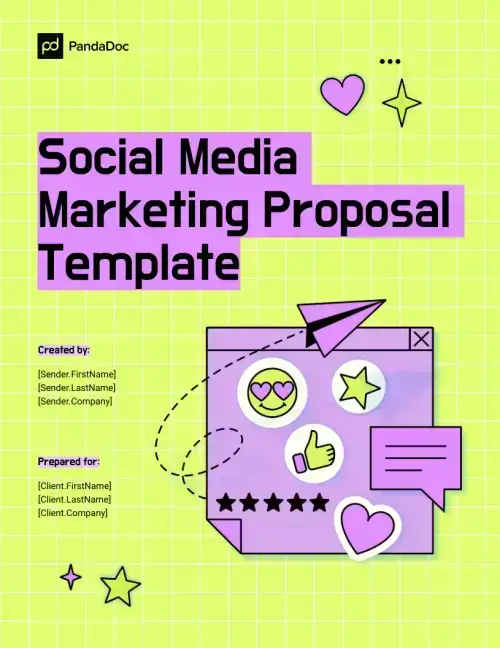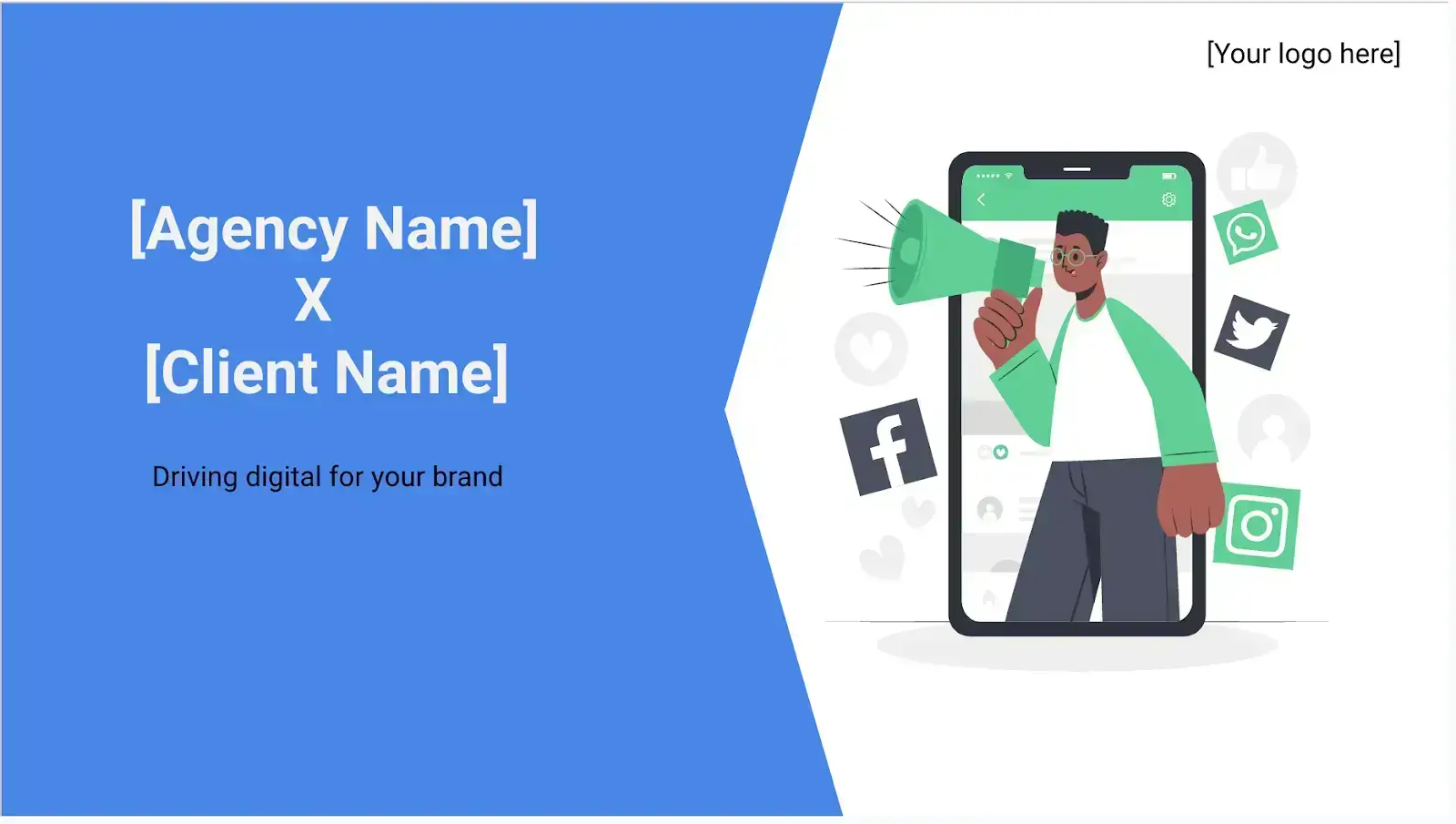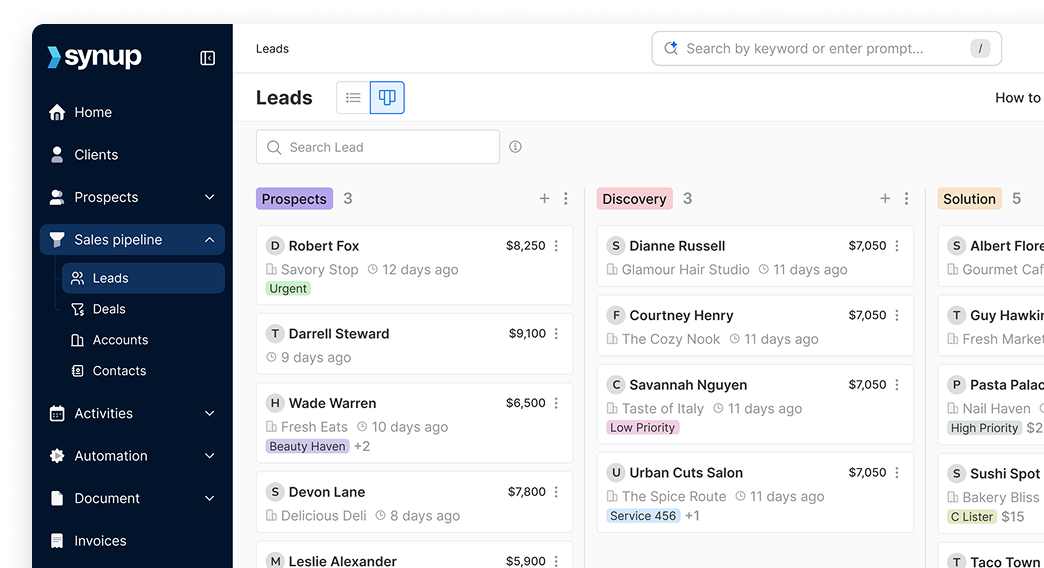How to Create a Marketing Proposal for Clients: Guide for Marketing Agencies
Looking to bag a big marketing gig? This article shows you how to write a marketing proposal that converts prospects, plus some client proposal templates to use.

You have the skills and a fantastic team; now, all you need are clients to get the ball rolling. A well-crafted marketing proposal is essential for this process. When writing a marketing proposal for clients, it’s crucial to demonstrate not only what you can do but also why your agency is the right fit for their needs.
An effective proposal clearly outlines your strategy while highlighting your agency’s unique value. It provides clients with a comprehensive understanding of how you plan to market their product or service and why they should choose you over the competition.
In this article, we will explore how to write a marketing proposal that effectively converts prospects into long-term partners.
What Is a Marketing Proposal and Why Is It Important for Agencies?
A marketing proposal for clients is a plan that highlights the marketing strategy and budget for a particular client or prospective.
Your agency’s elevator pitch shows clients exactly how you’ll help them win at the marketing game. You’re essentially laying out your game plan—what you’ll do, how you’ll do it, and why your strategy works or matters.
Some Benefits of a Marketing Proposal for Agencies
Some benefits of investing time into understanding how to write a marketing proposal:
- Helps Secure New Clients
A marketing agency proposal is your golden ticket to securing new clients. It's a strong, comprehensive, and persuasive tool designed to make potential clients feel like they need you on their team.
For instance, imagine pitching to a luxury real estate business in a developing country where purchasing power isn't very high. They’ve been handling marketing in-house, but they haven't been tapping into the right market.
Now they want to expand and bring in a marketer who can see what they may not be visualizing. Your proposal showcases how you’ll help them attract the diaspora crowd in more developed countries with greater purchasing power.
You’ll likely detail how you’ll help them boost their social media presence and target luxury buyers and diasporans using Google paid ads or Facebook lead ads.
In other words, you’re presenting them with the full package: how your services will help them grow, stand out, find new targets, and sell more. Essentially, you’re not just listing what you offer—you’re convincing them that your approach is superior. That’s what seals the deal.
The proposal outlines the game plan and makes the client eager to hire you.
- Differentiates You From the Pack
In a world where clients are bombarded by countless agencies and applications, you’ve got to stand out with a solid client proposal format.
Think about this: You’re pitching to a startup founder who’s swamped with proposals. Everyone promises the moon, but your proposal goes deeper than that. It showcases your unique expertise, structure, and attention to detail. You include real success stories of how you helped a similar brand grow by 300%. That’s what grabs attention.
To put it simply, a killer proposal doesn’t just talk the talk; it proves you’ve got the goods. In other words, you’re not just another agency—you’re The Agency. That’s what separates you from the pack!
- Builds Client Trust
Trust is everything in business. Clients want to know you’ve got your act together. A well-crafted marketing proposal for clients does just that. It communicates, "We’ve thought this through."
Using a real estate company as an example, imagine you sent a pitch to boost their online presence and generate leads.
Your proposal isn’t just a quick overview; it’s packed with research data. A Moz/Ahrefs domain rating analysis shows the website is languishing at under 20. Google Search Console data reveals they're not even targeting the right keywords and that the most engaged content comes from 2020-21 posts. They also run ad campaigns, but there’s a sea of leads with nothing flowing down the funnel because no one is following up.
You highlight a few of these mistakes and provide the exact steps to improve SEO, increase leads, and enhance social media engagement. The client sees the plan and instantly thinks, "These guys know their stuff."
In other words, a proposal proves you’ve done your homework and that you’re not winging it. Essentially, it makes clients feel safe putting their brand in your hands. Trust sealed likely means a deal is done.
- Shows You Understand the Client’s Business
A tailored marketing proposal for clients can also demonstrate that you understand their industry, their audience, and their challenges—and that goes a long way.
Let’s say you’re pitching to a gym owner. Even though this is your first time working in this industry, you’ve done your research and are not just throwing in some generic marketing ideas.
You highlight how your strategy will target their specific audience—fitness enthusiasts, newbies, and even those trying to get back into shape. You mention some of their local competitors, what they do, and what your potential clients are not doing. You discuss trends in fitness marketing and explain how you’ll help them during off-peak seasons.
In other words, you’re not just talking about marketing; you’re talking about their business. Essentially, you're showing that you've walked a mile in their shoes and are ready to help. That’s why they’ll feel like you’re the right fit.
- Serves as a Roadmap
Your marketing proposal isn’t just about winning the client; it will serve as your team’s roadmap for the entire project if you secure the contract.
Your proposal outlines every step, from the initial social media push to running targeted ads and even influencer collaborations. When your team gets into the thick of things, they won’t have to guess. The proposal lays it all out—who’s doing what, when, and how.
In other words, it’s not just for the client; it’s for you, too. Everyone knows the game plan, the deadlines, and what success looks like. Essentially, your proposal is the guide you’ll refer to every time someone asks, “What’s next?”
- For Cost Transparency and Measurable Outcomes
Nobody likes surprises, especially when it comes to funds. A great marketing proposal breaks down the budget, showing your clients exactly where every dollar is going—no hidden fees, no last-minute costs.
For example, say you’re working with a tech startup. They’ve got a tight budget, and they want to know how much is being spent on ads, content, and SEO. Your proposal lists it all out. They can see that $5K is allocated for Google ads, $3K for content creation, and $2K for social media management. Clear as day, the client understands why you're billing $10,000 for the project.
Plus, the proposal establishes measurable outcomes. It defines specific KPIs like website traffic, lead conversions, and social media engagement. So, when it’s time to track success, everyone knows what’s expected.
In other words, a good client proposal format keeps things transparent and ensures the client can see the value. Essentially, it’s you saying, “Here’s what we’re doing, here’s what it costs, and here’s how we’ll measure it.” No smoke and mirrors!
- Mitigates Risk of Scope Creep
Let’s face it—scope creep can be a total nightmare. You've probably experienced it countless times. You start a project, and suddenly, clients want extra features, more revisions, and more time.
Imagine you’re working with a fashion brand. You’ve agreed on a marketing campaign that includes social media ads and influencer partnerships. Your proposal lays it all out, detailing exactly what’s included. When the client asks for additional blog posts or a new website design, you can assuredly point out that it wasn’t in the proposal and will incur extra costs.
In other words, your proposal acts as a shield against extra work without extra pay. It keeps the project focused and ensures everyone knows what to expect.
How to Write a Marketing Proposal in Four Steps
Next, we'll explore how to write a marketing proposal for clients in four major steps, providing proven practical tips along the way. Some of these tips are applicable to professionals in other fields as well, whether you're seeking clients for online reputation management, web design, or SEO audits.
#1 Research and Understand the Client’s Business
Before you even think about pitching ideas, you need to do one thing—research! This should not be a last-minute surface-level research.
This should be a deep-dive, know-the-client-like-the-back-of-your-hand type of research.
Why Client Research Matters
Here’s the truth: you can’t create an exceptional marketing proposal without truly understanding the client’s business. It’s like trying to build a house without knowing the blueprint—it’s just not likely to work.
When the focus is on achieving real results and not merely views or likes, marketing is largely driven by research, with implementation playing a much smaller role. The key is to invest your time in understanding trends, analyzing competitors, and developing future projections. This approach can lead to substantial marketing success
It’s essential to take the time to study the client’s market. What’s working? What’s not? Who are their competitors, and how are they performing? This is where you can truly showcase your agency’s expertise. Once you have this information, you’ll be equipped with the insights needed to create a tailored strategy that meets their unique business needs, rather than relying on generic marketing tactics.

Use Research Tools
You can’t really wing it when it comes to research. Sure, you might know a few basics about the client, but you need real, concrete data to build a proposal that stands out.
Some research tools can give you the inside scoop on things without leaving you scratching your head. These tools provide insights into trends, competitor strategies, and what’s driving traffic in the industry.
Essentially, these tools help you look like a pro, and when it’s time to pitch, you’ll have all the facts and figures to back up your ideas. Plus, using research tools saves you time and gives you confidence that your strategies are on point.
- Google Trends (Free): Want to know if a topic or product is blowing up or fizzling out? Google Trends helps you spot what’s trending in your client’s industry. It’s perfect for understanding seasonality and consumer interest over time.
- Ubersuggest (Freemium): This one’s key for keyword research. You can use it to see what keywords your client’s competitors are ranking for and how to outrank them. It also suggests content ideas that align with those keywords. Ubersuggest, a product of Neil Patel, the co-founder of Crazy Egg, Stride, and HubSpot columnist, integrates into your Chrome browser as an extension and analyzes every page you visit.
- AnswerThePublic (Free): If you’ve ever wondered what questions people are asking online, this is your tool. AnswerThePublic gives you insights into the questions and concerns your client’s audience is searching for, so you can address them in your marketing strategies.
- Ahrefs (Freemium): Ahrefs is quite big on competitor analysis and domain authority checks. It shows you how popular or authoritative your client's site is, which sites are linking to their competitors, what keywords they rank for, and where they’re getting traffic. The insights here can help you build a stronger, data-driven proposal.
- SEMrush (Paid): SEMrush is a marketing toolkit in one place. It covers everything from SEO research and content marketing to ad strategies and social media tracking. If you want to pitch a full digital strategy, this tool has your back.
With these tools, you’re armed to the teeth with insights, stats, and trends. So, when it’s time to present your proposal, you’re not just making suggestions. You’re serving up strategies backed by data. And that is how you win clients.
Good and Bad Practices for Client Research
Before moving ahead with a proposal, you’ve got to know your client like the back of your hand. However, there’s a correct way to go about it. Here are the do’s and don’ts of client research so you can avoid facepalm moments and build a proposal that leaves a lasting impression.
Do
- Deep dives into the client’s industry: Know the trends, the pain points, and what’s moving the needle in their market.
- Study their competitors: Find out what the competition is up to. What’s working for them? What can your client do better?
- Review client case studies or testimonials: Look at their past wins and challenges. This helps you see where they are stronger and where they need support.
- Get familiar with their target audience: Who are they marketing to? What are their customers’ needs, wants, and frustrations?
- Check their online presence: How are their website, social media, and SEO performing? This is where you can spot quick wins and suggest improvements.
Don't
- Rely only on the client’s website: You need more than surface-level info. Don’t limit yourself to what’s on the homepage or “About Us” section. They may not be up-to-date.
- Assume they know their audience well: Spoiler alert: your client might not. So, dig deeper. Help them find something new by using research tools to verify audience insights.
- Use outdated or irrelevant data: Don’t pitch strategies based on trends from 2019 or more than three years ago. Keep it fresh and current.
- Go in blind: You can’t fake it with this task. Doing the bare minimum research will show—and not in a good way.
By following these best practices, you’ll enter your proposal meeting fully prepared to demonstrate how your expertise can help your client excel in the market.
#2 Key Sections to Include in a Marketing Proposal
Now that you've done your homework (a.k.a. research), it's time to put together the actual proposal. But where do you start?
Let’s break down the key sections of a great marketing proposal for clients, and how to write them so they don't send your client into snooze mode.
- Executive Summary
Think of this as the trailer for your proposal. It's short, snappy, and highlights the best parts. Use this to give an overview of the client's current situation and your recommended approach. Don’t go into all the details yet. This is just a teaser to get them excited. Keep it high-level and to the point. Make them want to read more.
- Situation Analysis
Here’s where you use your research. Lay out what you’ve learned about the client’s business, industry, and competitors. Talk about their current strengths, weaknesses, opportunities, and threats (the classic SWOT). This section shows you get the client and are ready to tackle their unique challenges. Bonus tip: bring in some stats or data from your research tools to back it up!
- Marketing Objectives
Now, it’s time to outline the goals. What are the specific outcomes the client wants to achieve? Whether it’s boosting website traffic, increasing leads, or growing brand awareness, be crystal clear on what success looks like.
Make sure these goals are SMART—specific, measurable, achievable, relevant, and time-bound. Clients love a plan that involves real numbers.
- Strategy and Tactics
You’ve told them what you’ll do; now, show them how. Break down your overall strategy into bite-sized tactics. Think of it like planning a road trip: the strategy is the route, and the tactics are the pit stops.
Cover things like content marketing, SEO, social media, email campaigns, or whatever else fits the bill. The more specific, the better. And don’t forget to tie each tactic back to their objectives. Clients want to see that everything has a purpose.
- Target Consumers
Another key point: let your client know you have an idea of who they are trying to reach. Everyone is not an answer. You’ve got to define the specific group of people your client wants to reach.
You need to nail down who the target consumers are, how you’ll reach them, and how you’ll keep them coming back. The right marketing plan identifies everything from who your target customers are, how to reach them, and how to retain them so they buy repeatedly.
In your proposal, make this section super clear. Define the demographics, interests, and behaviors of your client's ideal customer. The more specific, the better.
- Scope of Your Services
This is where you list exactly what the client gets. Outline every service you’ll provide, whether it’s social media management, content creation, or running ads.
Be specific about what’s included and what’s not, so there's no conversation about “extra” services later. The client needs to have a clear understanding of what’s being offered and what is not.
- Budget and Pricing
Be upfront about costs. Clients appreciate clarity here, and no one likes surprises when the invoice shows up.
Break down the budget by service, so they see exactly what they’re paying for. You can structure it by deliverables (e.g., X dollars for SEO services) or by project phases. And if there are any optional extras, add them in as add-ons. Make them appealing, but not overwhelming.
- Case Studies and Testimonials
Display your past work and let your results speak for themselves. Include case studies that showcase similar projects you’ve crushed, focusing on the numbers (clients love stats!).
Have you got some glowing testimonials in your LinkedIn? Drop a link in here too. Customer. This section builds credibility and proves that you can deliver.
- Measurement and KPIs
Clients want to know how you’ll track success, and that’s where this section comes in. Set clear KPIs (Key Performance Indicators) so they know what to expect. Whether it’s website traffic, lead generation, or social media engagement, explain how you’ll measure progress.
#3 Customizing Proposals Based on Client Needs
Let’s be real—there’s no one-size-fits-all when it comes to a marketing proposal for clients. Each one is different. They’ve got unique goals, challenges, and quirks. And your job is to tailor that proposal to truly fit.
Here’s how to do it:
Focus on Client Goals and Challenges
First off, figure out what your client really wants. Are they looking to boost sales? Grow their social following? Launch a new product? Once you understand their goals, you can build your proposal around that.
Think about it like this: if your client’s goal is to scale up their user base, you wouldn’t suggest a quick, one-time ad campaign, right? The same goes for marketing. Your proposal should focus on strategies that drive long-term growth, not just short-term wins.
Address their pain points as well. If they’re struggling to reach a specific demographic, highlight how your plan directly tackles that challenge.
Tailor It to Their Industry
Next, speak their language. A proposal for a tech company shouldn’t sound the same as one for a fashion brand. They’re playing on different fields with different rules.
A tech company might want to hear about SEO and data-driven insights. A fashion brand is likely to care about visuals, trends, and influencer partnerships.
Demonstrate that you understand this. Drop in industry-specific examples or case studies. Maybe your client is in the fitness industry—talk about how social media can fuel engagement or how email campaigns can drive class sign-ups.
Keep it Client-Centered
Make the client feel like the main focus—because they are. Avoid giving them a generic plan. Instead, tailor your proposal to their brand by incorporating their business goals, using their name, and addressing their specific needs.
Customization is key. The more personalized your proposal, the more likely the client will feel it's the perfect fit.
Here’s a tip: adding the client’s logo or branding to the proposal shows you care. Incorporating their colors, fonts, or even screenshots of their website adds a thoughtful touch that makes a big impact.
This attention to detail shows you’ve done your homework, helping the client visualize working with you.
Address Payment Concerns
Clients are always going to ask about financial resources—and flexibility. They want to know if they’re getting what they’re paying for. So, make it easy. Address pricing upfront. Offer different packages or payment plan options if possible. Maybe they’re looking for flexibility, like scaling services up or down based on results. Show them you’re not just a marketing machine—you’re human and understand their need for a win-win situation.
Clients want to understand their options clearly before committing to your marketing services. Be transparent and give them a sense of control by laying out all the details upfront.
Be Ready to Tweak on the Go
Customizing also means being flexible, not just with payments but with the plan itself. Maybe they want to start small and grow as they see results. That’s fine! Show them you can adapt. Maybe they’re unsure about which channels to focus on. Give them room to tweak the strategy as you go.
Ultimately, customizing a proposal isn’t just about adding their logo or tweaking the price. It’s about showing them you understand their unique (and often evolving) needs and that you’re ready to meet them where they are.
#4 Client Proposal Templates for Marketing Agencies
Writing a marketing proposal from scratch can feel like climbing a mountain. Luckily, there are some top client proposal templates out there that do the difficult tasks for you. Whether you’re a newbie or a seasoned marketer, these client proposal formats can save you tons of time and give your proposal that polished professional look.
Here’s a quick overview of some of the best ones out there.
Proposify’s Customizable Digital Marketing Template
Need something with more details, just as explained in this article? Proposify’s templates are fully customizable, letting you add your client’s branding, images, and key sections. It even comes with a built-in e-signature feature, so your clients can sign the deal in seconds. All you need is to click “Use this template” at the bottom of the proposal template page, sign up to Proposify and start with a 14-day free trial.

Check out other Proposify templates.
HubSpot’s Marketing Proposal Template
If you’re looking for client proposal templates that are sleek and easy to use, HubSpot has you covered. Their proposal template is clean, simple, and checks the key boxes. It comes with ready-made sections for your team and services. Plus, it’s free.

Go through all of Hubspot's proposal templates.
PandaDoc’s Marketing Proposal Template
PandaDoc offers super user-friendly templates with drag-and-drop elements. It’s perfect if you like flexibility in creating your proposal. You can adjust everything—from design to content—while still keeping it easy to follow. It’s like having a blank canvas, but with all the tools you need right there. They have various proposals for various marketing niches.

Check out PandaDoc's proposal templates.
Synup’s Custom Proposal Templates
Now, if you want something tailor-made for your marketing agency, you’ll want to check out Synup for a custom proposal template. These templates are designed to help you stand out from the crowd, with sections optimized for SEO, PPC, social media, and more. Why spend hours building a proposal when you can just plug-and-play?

Find more templates by Synup here
Summing Up
And there you have it. Now you know how to write a marketing proposal that’ll wow clients and close deals. Start by understanding your client’s needs, then customize your approach with flexible pricing, personalized branding, and the right client proposal format.
Whether you’re using popular client proposal templates or creating from scratch, focus on being clear, concise, and client-centered. With these tips, your marketing agency proposal will be the one they can’t resist. Go craft that winning pitch!
How to Create a Marketing Proposal for Clients: FAQs
What is the purpose of a marketing proposal?
The purpose of a marketing proposal is essentially to outline your strategy for helping a client achieve their goals. It’s your opportunity to show how you’ll tackle their challenges and drive results. A solid proposal helps clients clearly see the value in what you offer, making it easier to move toward a signed contract faster.
How do I research a client's business?
Start by checking out their website and social media. Form a conclusion on what their online reputation is from social media comments, ratings, and reviews. Look for their mission, products, and target audience. Tools like Ahrefs, Google Analytics can also help you understand their current performance. It also helps to analyze their competitors to see what’s working for them and what your proposed client isn't doing or is doing incorrectly.
What are the 4 C's in a proposal?
The 4 C's of a standout proposal are client, cost, content, and context. First, know your client: understand their needs and pain points to customize a winning approach. Next, outline the costs involved; be transparent and break it down. After that, focus on the content. Detail your strategies in a clear, easy-to-digest format. Finally, provide context by discussing the market landscape and how your strategy fits in. These 4 C's ensure your proposals are clear, concise, comprehensive, and compelling, helping your marketing agency stand out to potential clients.




